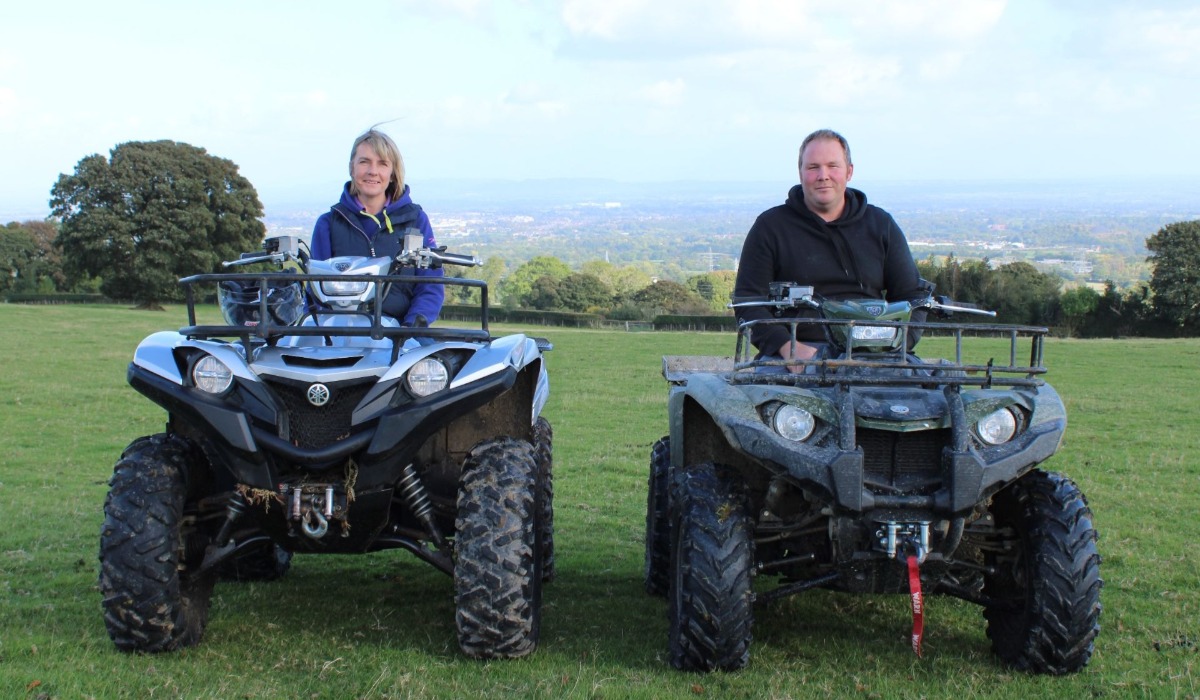
Choosing between ATV power outputs
ATVs are commonly offered with a fairly limited choice of large or small engine. Typically these are 700cc or 450cc petrol injection or diesel engines with either manual or CVT transmission. There are subtle, but important, variations in stature, versatility, comfort and performance. However, is it a case of spot the difference? or are there real benefits to be had by selecting one over the other? We spoke to husband and wife, Aled and Emily Roberts, to find out.
Choosing between ATV power outputs
ATVs are commonly offered with a fairly limited choice of large or small engine. Typically these are 700cc or 450cc petrol injection or diesel engines with either manual or CVT transmission. There are subtle, but important, variations in stature, versatility, comfort and performance. However, is it a case of spot the difference? or are there real benefits to be had by selecting one over the other? We spoke to husband and wife, Aled and Emily Roberts, to find out.
Aled and wife Emily both help to run their respective family farms near Wrexham. Emily works with her father to manage 1000 ewes and 250 ewe lambs over 500 acres (202 ha) along with additional arable and mountain grazing land. Thirty miles away, husband Aled runs his family farm with 500 ewes and 150 ewe lambs over 200 acres.
Both spend most of their time on ATVs, an essential tool for everyday farming tasks. However, Emily has the range topping 700cc Yamaha Grizzly, one of the biggest and most powerful ATVs available, whilst Aled has opted for the smaller Yamaha Kodiak 450 EPS. The machines were both supplied new by their local dealer and form part of a long line of Yamaha machines owned by the couple. After years of owning 700cc ATVs, Aled has moved to a lower power 450cc model, whilst Emily has chosen to stick with more powerful 700cc machines for fifteen years.
Explaining her choice, Emily says:
“Our farming system sees the Welsh Mountain ewes take full advantage of mountain grazing rights. It enables us to make best use of the mountain, but it requires a lot of gathering sheep throughout the year. Therefore I have a 700cc machine, because the power of the bike manages the mountainous terrain better.
On paper the two machines have very similar weight carrying capabilities. The 700 has a slightly larger rack capacity of 140 kilos compared to the 120 kilos of the 450 model. However, the towing limit for the 450, at 500 kilos, is a full 100 kilos shy of the 700’s 600 kilo limit.
“I would also suggest that the figures are accurate for when the ATV is on the flat, but with the gradients and tricky terrain I face on the mountain, I would say the 700cc Grizzly offers greater stability, ground clearance and braking capacity,” she adds.
At 1500 feet above sea level, the top of Ruabon Moor is 600 feet above the farm. Moving sheep through even well-known areas can be treacherous, not least because of the bomb holes.
“Following the Second World War, hundreds of bomb holes were found on top of the moor. To confuse Luftwaffe pilots sent to bomb Liverpool, lights were situated on the moors to draw their bombs. The result is a heavily pitted landscape caused by the bombs they released. Now covered with bracken, they are impossible to see so I need a rugged machine with plenty of power to traverse them, especially if I’m carrying any weight,” she says.
Emily has also chosen to use dual wheels for stability in the toughest conditions. The size of the wheels and ground clearance on the larger Grizzly are both factors that help her to manage on the tough terrain. The 14 inch wheels are 2 inches wider than the Kodiak and ground clearance is 43mm greater. Both ATVs have adjustable independent double wishbone suspension, but the 700 has 22mm greater wheel travel at the front and 43mm at the rear.
“Ground clearance is a big factor for me and I have chosen to have the ‘chunky’ tyres fitted too for added grip. If I had the smaller 450 I would wear the tyres out and burn more fuel trying to rev it over the hard ground. I would also expect to damage the underside on rocks and I can’t afford this when I have no phone signal on top of the mountain. I also like the Warn winch which comes as standard and has come in handy a few times,” she says.
Braking is a significant factor for any ATV, especially those like the Yamahas which have a CVT transmission. The smaller 450 has dual hydraulic discs on the front and sealed oil bathed multi discs on the rear. However, to cope with the extra weight and power, the larger 700 has dual ventilated hydraulic discs all round.
“I need to be able to stop whilst carrying almost a ton of weight and descending steep hills. The engine brakes very well for a CVT transmission, but it is imperative that I can trust the brakes to stop me quickly and safely,” she says.
Electric power steering is standard on the Grizzly, and an option on the Kodiak. Adding it increases the price of the smaller model, but it is still more than £3,000 cheaper with this option. Both have switchable 2- and 4-wheel drive operated by a switch on the handlebars. The larger ATV has a price tag of £14,760 whilst the 450 with a similar spec is £11,280. And this is where Aled’s argument for the smaller model gathers weight.
“For the work I do, I neither need the extra power or size of a 700cc machine. I like the smaller dimensions of the 450. It allows me to move it with my bodyweight more easily and the seating position is more in the ATV than on top of it. I am also sure I have reduced my fuel bill by switching to the smaller engine,” he says.
The 450 is also more compact. At 1180mm wide it is 50mm narrower than the 700 and 35mm shorter. Whilst this seems insignificant, it has made a crucial difference for Aled.
“I have a livestock container with a hydraulic deck system. I can carry 120 sheep in the main body and the ATV is low enough to fit above on the top deck. I only need one vehicle to transport both livestock and ATV, enabling me to unload the ATV at my destination and use it to round the sheep up. By not having to take a second vehicle I am saving time and fuel, and can operate alone,” he says.
He also has the added advantage of lambing outside which reduces his reliance on a trailer to move ewes and lambs. He operates a forage rotational grazing system where the sheep are out all year, making the ATV a tool for checking and feeding the flock rather than transporting them.
“I have added aluminium plates for the dogs on the back and, like Emily’s 700, I have a winch as standard, but I rarely have to use it. It is surprising how different the work is when the farms are not that far apart, but it is the main reason why I chose to downsize, I just don’t need the added power and cost,” he says.
Fuel consumption figures are rarely stated for ATVs, due to the varied nature of the mileages covered. Aled suggests he is saving significantly following the switch, but Emily is unsure she would see the same benefit.
“I’m definitely using less fuel after having downsized. My guess would be that over the 1500 miles I cover in a year the saving would be hundreds of pounds,” says Aled. However, Emily counters saying,
“I would be using a 450cc ATV at its limit and revving the engine all the time to get the performance I need. This is why I don’t think there would be a significant saving for me.”
Like the farms that choose them, ATVs are far from generic. The choice of engine size, transmission and load capacity can make the difference between spending thousands of pounds and saving many hours of work.
“Life would be so much harder for me if I had to use Aled’s machine, and it would be much more expensive if he used mine. So, we have the right tool for our respective farms and we wouldn’t be able to do without them for a day,” she concludes.


